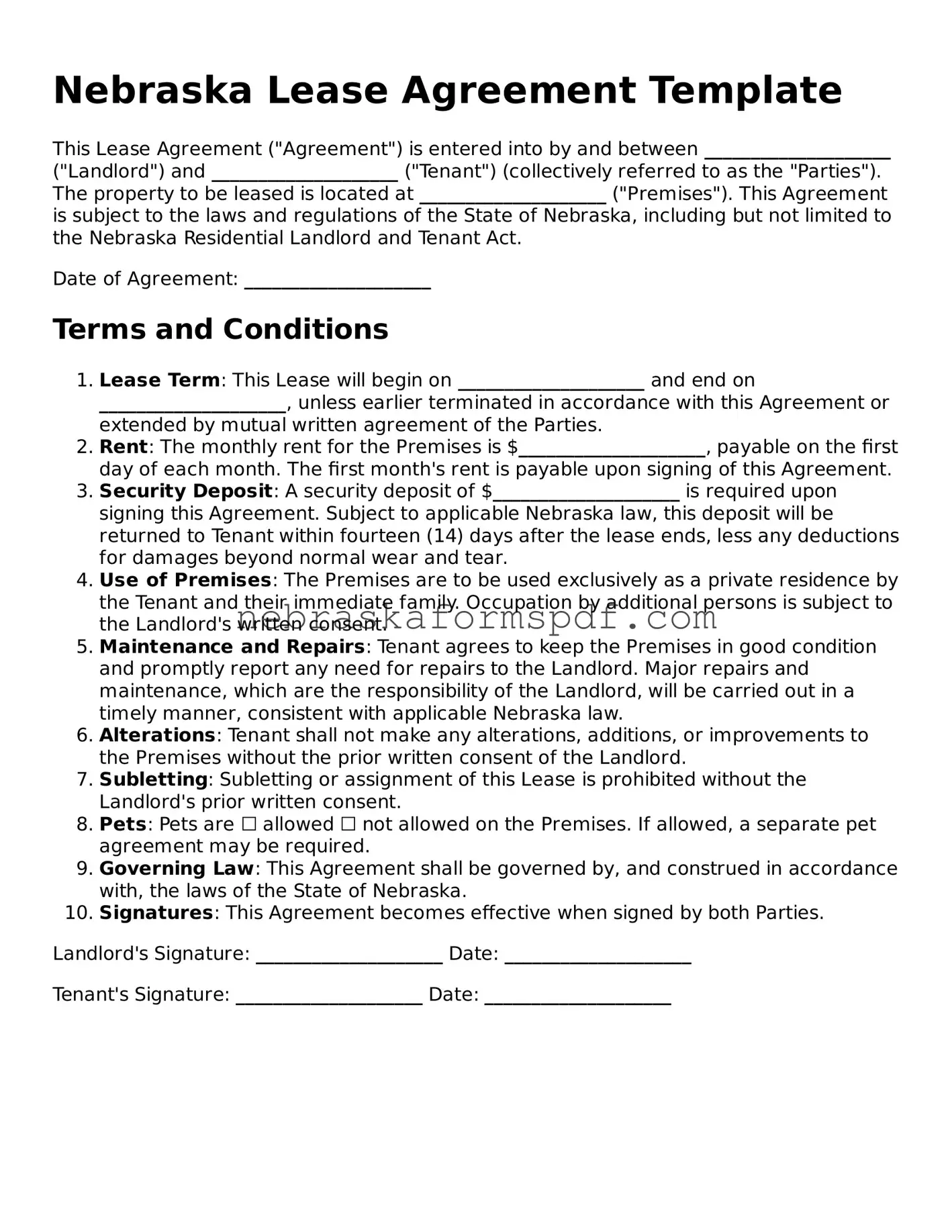What is a Nebraska Lease Agreement?
A Nebraska Lease Agreement is a legally binding document between a landlord and a tenant that outlines the terms and conditions of renting property in the state of Nebraska. This agreement specifies details such as the duration of the lease, monthly rent, security deposit, and the rights and responsibilities of both the landlord and the tenant. It is crucial for both parties to understand and agree to these terms before signing to ensure a smooth rental experience.
What types of Nebraska Lease Agreements are there?
There are several types of Nebraska Lease Agreements, each catering to different rental needs, including:
-
Standard Residential Lease:
The most common form used for renting out homes, apartments, and condominiums on a fixed-term basis, usually for one year.
-
Month-to-Month Lease:
Offers flexibility by allowing the tenant or landlord to terminate the lease at any time with proper notice, usually 30 days.
-
Commercial Lease:
Used for renting out commercial properties, and it typically includes terms specific to business uses.
-
Sublease Agreement:
Allows the current tenant to rent out the property to another tenant, with the landlord's approval.
-
Roommate Agreement:
A contract made between tenants sharing the same rental unit, outlining each person's responsibilities.
How long can a lease agreement last in Nebraska?
The length of a lease agreement in Nebraska can vary. Residential lease agreements are commonly set for a period of 12 months, but they can be shorter or longer depending on what the landlord and tenant agree upon. Month-to-month lease agreements are also popular, offering flexibility to both parties to change or terminate the agreement with 30 days' notice.
Is a security deposit always required?
No, a security deposit is not always required in Nebraska, but it is a common practice. Landlords may ask for a security deposit to cover potential damages to the property, unpaid rent, or other liabilities. Nebraska law limits the amount a landlord can charge for a security deposit to one month's rent (for unfurnished units) and no limit for furnished units, excluding pet deposits. Landlords are required to return the deposit within 14 days after the lease ends and the tenant provides a forwarding address, minus any deductions for damages beyond normal wear and tear.
What should be included in a Nebraska Lease Agreement?
A Nebraska Lease Agreement should include, but not be limited to, the following information:
-
The names and contact information of the landlord and tenant(s).
-
The address and description of the rental property.
-
The term of the lease and the start and end dates.
-
The amount of rent, when it's due, and how it should be paid.
-
The amount and terms of the security deposit.
-
Any additional fees and utilities responsibilities.
-
Rules and policies about pets, noise, and property upkeep.
-
Conditions under which the landlord may enter the property.
-
Termination and renewal terms.
-
Signatures of both parties.
Can a lease agreement be terminated early in Nebraska?
Yes, a lease agreement can be terminated early in Nebraska under certain conditions, such as mutual agreement between the landlord and tenant, military service deployment, substantial violation of the lease terms, or through early termination rights specified in the lease itself. Tenants who break a lease without just cause may be responsible for the remainder of the rent due under the lease, though landlords are required to make a good-fait effort to re-rent the property.
What happens if rent is paid late?
If rent is paid late in Nebraska, the landlord may charge a late fee as specified in the lease agreement. Nebraska law does not set a maximum limit for late fees, but they must be reasonable. Typically, landlords will provide a grace period (often 3-5 days) before charging any late fees. If the tenant fails to pay rent after receiving a notice to quit (usually giving them 3 to 5 days to pay), the landlord may proceed with eviction proceedings.
Are pets allowed in rental properties?
Whether pets are allowed in rental properties is at the discretion of the landlord. If pets are allowed, the lease agreement should specify any terms related to pets, such as restrictions on types or sizes of pets, the number of pets allowed, and any additional pet deposits or fees. Some Nebraska landlords choose to include a "no pet" policy, while others may allow pets with certain conditions.
How do maintenance and repairs get handled?
In Nebraska, landlords are responsible for maintaining the rental property in a habitable condition, complying with all health and building codes. This includes making necessary repairs to essential services such as heating, plumbing, and electricity. Tenants are typically responsible for keeping the property clean and paying for damages that result from their negligence or abuse. The lease agreement should outline how maintenance requests are reported and handled.
Nebraska Lease Agreement forms can be found online through various legal websites, at attorney offices, or by contacting the Nebraska Real Estate Commission. It's important to use a form that complies with Nebraska laws and to possibly consult with a legal professional to ensure the lease agreement meets all legal requirements and adequately protects your rights, whether you are a landlord or a tenant.
